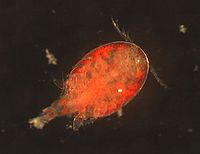Clausidium vancouverense
From marinelife1011
| Red copepod | |
|---|---|
 |
|
| The red copepod that was found on a Neotrypaea californiensis from TESC beach taken by Elizabeth Nelson | |
| Scientific classification | |
| Kingdom: | Animalia |
| Phylum: | Arthropoda |
| Subphylum: | Crustacea |
| Class: | Maxillopoda |
| Subclass: | Copepoda |
| Order: | Poecilostomatoida |
| Family: | Clausidiidae |
| Genus: | Clausidium |
| Species: | C. vancouverense |
| Binomial name | |
| Clausidium vancouverense Haddon, 1912 |
|
Clausidium vancouverense, the red copepod, has a symbiotic relationship with Neotrypaea californiensis, and is one of six species in the genus Clausidium. [1] The red copepod was also known under the name Hersilia vancouverensis.
Contents |
Description
Females can grow in length from 1.086–1.222 millimeters the female is larger than the male; the female can also sometimes carry the male attached to her dorsal thorax. The first leg of the females have blade like seta on the first leg and two on the second endopodite podomere of the second and third legs. The fifth leg on the female also has minute lateral hairs on the setae, the males also have a distinctive maxilliped.[2]
Ecology
Clausidium vancouverense dispersal on the ghost shrimp is positively correlated to the host body size, but not the host’s sex. It attaches itself to the ghost shrimp with suckers on the branchial cavity.[3]
Distribution
Clausidium vancouverense are found in combination with the bay ghost shrimp (Neotrypaea californiensis) or blue mud shrimp (Upogebia pugettensis) so the range is the same. They are found in the Pacific Ocean in the intertidal zone from Baja California to Alaska.
Predators
The predators to the Clausidium vancouverense are the same as the Neotrypaea californiensis since the copepods live on the ghost shrimp. The predators of the Neotrypaea californiensis are Pacific staghorn sculpin (Leptocottus armatus), a fish that is found in the coastal waters of the pacific coast from Alaska to Baja California.
References
- ↑ C.B. Wilson (1935). "Parasitic copepods from the Pacific coast". American Midland Naturalist 16: 776–797. Bibliography of Copepoda, up to and Including 1980: Part 1 (A-G)
- ↑ A. D. Humes (1949). "A new copepod (Cyclopoida: Clausidiidae) parasitic on mud shrimps in Louisiana". Transactions of the American Microscopical Society 68: 93–103Parasitic Copepods from the Pacific Coast.
- ↑ S.L. Marin & M. George-Nascimento (1975). "Tamaño corporal y hábitat del nape Callianassa garthi Retamal, 1975 (Crustacea: Thalassinidea) como factores que afectan la distribución y abundancia del copépodo Clausidium sp. (Cyclopoida) [Host body size and habitat as factors affecting the distribution and abundance of the copepod Clausidium sp. (Cyclopoida), ectosymbiont of the ghost shrimp Callianassa garthi Retamal, 1975 (Crustacea: Thalassinidea)]" .Revista Chilena de Historia Natural 66: 427–437.

